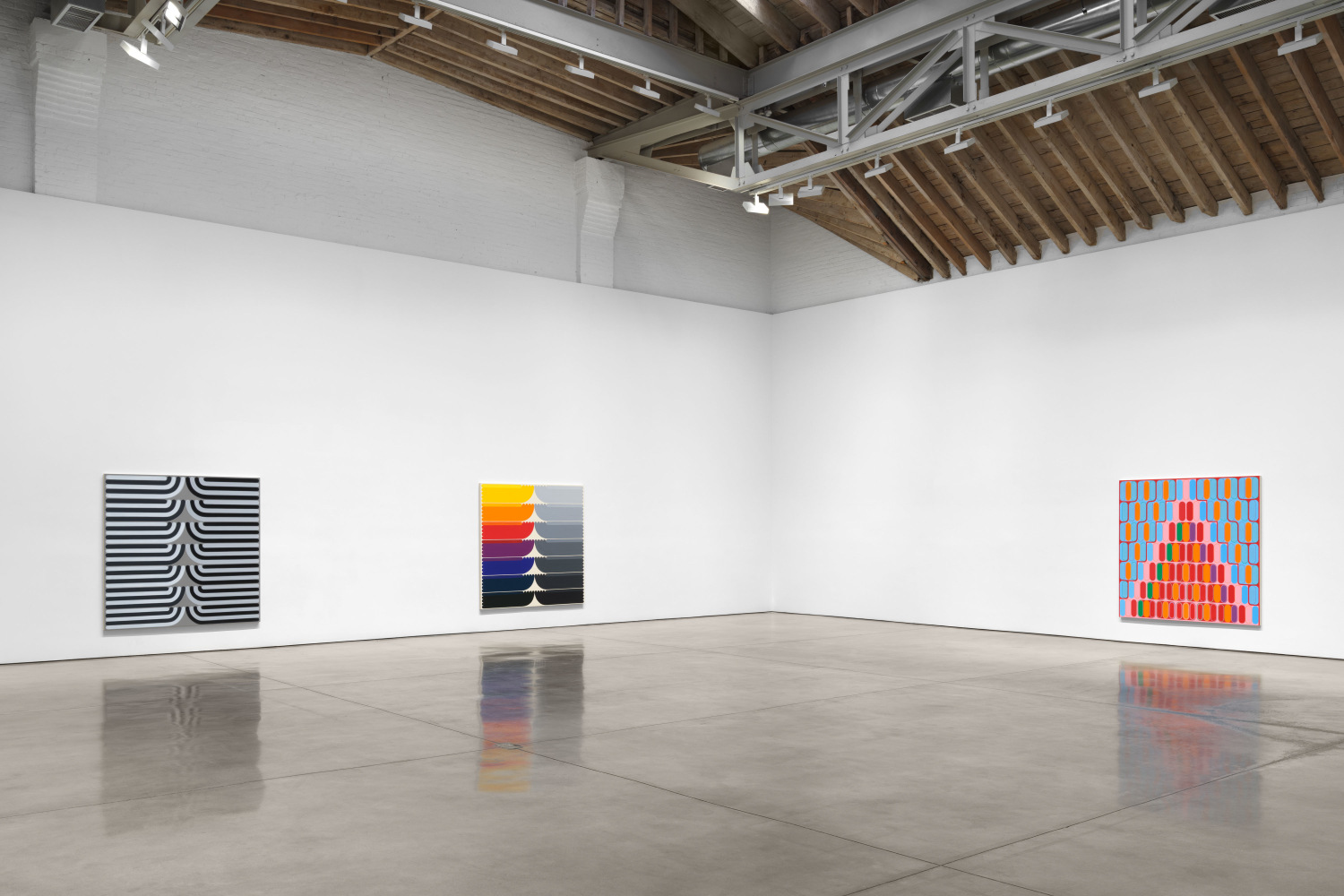
Installation view, Dan Walsh, Paula Cooper Gallery, New York, April 4 – May 18, 2024. © Dan Walsh. Courtesy Paula Cooper Gallery, New York. Photo: Steven Probert.
Dan Walsh’s newest exhibition finds the artist continuing his career-long investigation of unit-based cellular forms. His structures are familiar and recurrent: elongated rectangles shortened into fan-shaped brushstrokes, vertically stacked pyramids, and lozenges, sometimes in supine repose and elsewhere stacked into matrices of pill-like cells. Walsh’s confectionary palette and façade-like lozenges dovetail a Pop Art bereft of worldly references with an Op Art cleansed of thorough-going perceptual illusions. At the same time, Walsh’s use of the grid as a structural foundation betrays the influence of Minimalism while his insistence on an evenly filled picture plane forecloses the negative space necessary to truly develop a trellis or other such formal latticework. Ultimately, while Walsh’s architectonic layering of lozenges certainly has its roots in the grids of Donald Judd, Richard Serra, Carl Andre, and Agnes Martin, he is not a card-carrying Minimalist. Indeed, he is in fact something of a Maximalist, as his overpopulation of shapes-cum-forms flies in the face of the quietude and restraint so characteristic of historical Minimalism. Where other research-based artists, like Mary Lum, thread Modernist art history by collating its genres into a kind of collage, Walsh is neither a chronicler nor a practitioner of admixture. Instead, he is devoted to the slippage of mid-twentieth century approaches to shape, showing that the variegated modes of Modernism cannot help but intrude upon each other when it comes to the consideration of color as form.
Where Walsh has genuinely advanced in this show is in his colorism, which in turn leads to the formal refinement of his lozenges. This makes his new works much more aesthetically captivating than precursors like Saffron (2013) and Waive (2019), where uncongealed wine and amber capsules bled into their background. A set of recent watercolors, LHP-WC 19, LHP-WC 21, LHP-WC 22 (all 2024), evince an interest in color theory which attends to the reduction of his brushstrokes to upturned sinusoidal gestures. Primary colors (red, blue, yellow) are layered in bisected cleaves that give way to halves painted in secondary colors (purple, green). Wedge-shaped pockets indicate where the flaxen-gray, tangerine-amber, and cherry-plume fans roll back into themselves. These junctures create attenuated diamonds and half-diamonds of negative space, an orderly constellation of alabaster that appears, counter-intuitively, to be filled in. The colorful bands of rounded color and the underlying canvas are set into a non-hierarchical and even relation. Making form out of color—painted and unpainted alike—Walsh’s watercolors map the structures that govern how the brush is applied to the rectangular shape of the support before contravening it by undulating upwards. One can imagine here the circular roll of the artist’s wrist, the process of the form’s making made legible through the flabellate modules’ rising tide. These watercolors are Walsh’s quieter experiments, in keeping with his predilection for shape-as-form, following Kenneth Noland and Frank Stella’s stripe paintings and chevrons.
In the second room are recent acrylic lozenge paintings, including Stereo, Rate, and Release (all 2023). All three feature multiple vertical lozenges painted in aureate and hay yellows, lime greens, ultramarine blues, and flesh-roseate pinks. In all of these paintings, the lozenges consolidate into the shape of a pyramid. There are two means by which Walsh achieves this optical effect. In some cases he leaves various shapes in outline and fills in only the more central ones, which gives the appearance of an exchange between retrogressing background and inclining foreground. In others he takes advantage of the permutation of color within his shapes, a device inspired by Adolph Gottlieb’s pictographs from the 1940s and early 1950s and Rauschenberg’s cipher, White Painting with Numbers (1949). At times Walsh unifies both techniques, repeating his variegated capsules within an increasingly contracted grid. Many of his paintings locate a single lozenge crowning the top of the picture plane like the alam atop a minaret. Such triangulation has the effect of a weighted bottom, isomorphic to the verticality that, as Leo Steinberg notes in Other Criteria, is akin to the “normal erect posture” that percipients necessarily possess when viewing a painting. This makes our optical engagement—our taking in and parsing Walsh’s permutations—a seamless process in bodily terms.
Walsh’s paintings are “all-over,” though his rhythm is not the stochastic darting of splatters and skeins. It is the “all-over” of a Morse code signal, serial and progressive. Unlike Noland and Stella, Walsh leaves little room for the presence of the support, as much of the canvas is evenly coated and recoated. Unlike Op Artists, too, he is less concerned with optical three-dimensionality than the suggestion of depth, achieved through layering repeated structures in faint gradations of color. For an artist as attuned to art history as Walsh, it might be easy to lapse into an indifference to beauty. But his theoretical interests are balanced by an attentiveness to meditative patterns such as those found in Tibetan mandalas, textiles, and decorative art. Although some of his past works have shirked the sensuous, this is not the case in the series now on view at Paula Cooper. As Walsh noted in a recent interview with Jennifer Samet, he aims to make work that is “user-friendly.” Here he has succeeded decisively.
— Ekin Erkan